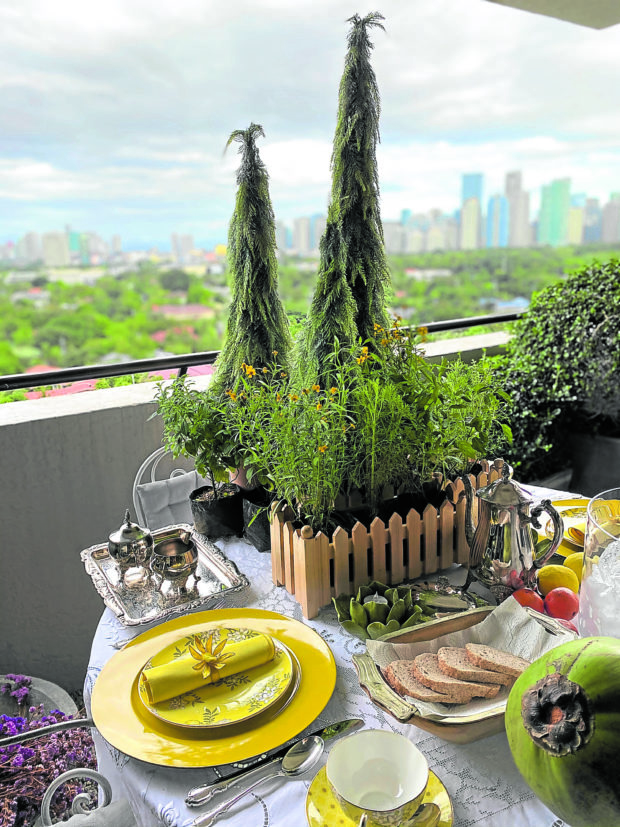
In celebrating the holidays under quarantine, table settings should be extra special, maintains entrepreneur, hostess and woman about town Nina Halley.
For Lifestyle, her year-ender dinner setup is dressed up in a sophisticated gold and black color scheme.
“It’s all about glitter and darkness,” she says. The gold ornaments symbolize festivity, while the black accents represent the pandemic’s impact in our lives. Even so, she looks at 2020 as a year of awakening triggered by challenges.
Stretched across the acacia table, the black plant box centerpiece has traditional elements of pine leaves, pine cones, kamuning leaves spray-painted gold and Christmas balls. Although Halley winces at the sparkly gold balls, she rationalizes that shine is important to contrast with the matte texture of the other balls.
The gold theme is echoed by the sprinkling of homemade stars, gold-wrapped Ferrero Rocher chocolates and tea lights. For visual impact, yellow lilies, eucalyptus and yucca leaves in a tall vase are balanced by several acacia pillar candleholders.
A black linen napkin, tied up with metallic branches and a gold pine cone, rests on a stack of gold-rimmed bone china and a matte gold charger. An amber-toned goblet adds warmth to the setting. Whether celebrating alone or with a small group, the champagne flute is a must for the celebratory toast.
In contrast to the restrained elegance of the dinner arrangement, the New Year’s Day breakfast setting heralds optimism with live plants, fresh fruits and bright colors. The table is dressed with exquisitely embroidered Irish linen. Wooden plant boxes, inspired by picket fences, are filled with fresh thyme, tarragon flowers, sage and dill.
Halley contrasts the urbanity of the yellow, printed Wedgwood plates with the rusticity of the porcelain artichoke candleholder and the fresh coconuts. The table is littered with kiat-kiat, a New Year symbol for money.
Quarantine fatigue
“The year 2020 may have been difficult, but I had the gift of time to be introspective and to weigh matters that were more important,” says Halley.
Last year, Halley, a proponent of Tango Argentino, spent many months traveling around the world, organizing dance classes for Julio Bassan, a Unesco referente (reference authority). In January, she and Bassan attended a tango conference, but were stranded when Ninoy Aquino International Airport was closed due to the Taal Volcano eruption.
Coming back to Manila, she became busy with her 41-year-old flower shop, The Love Garden, and the socials.
At the start of the lockdown, Halley thought she could finally indulge in her interests—piano playing, painting, reading and exercising. With more time for a spiritual life, she set up an heirloom kneeler and church candelabra in her room for the virtual Mass of Pope Francis and the evening rosary prayer.
The Love Garden was reopened before Mother’s Day. The demand had changed. Death notices became more pronounced throughout the quarantine. Most of the orders were delivered to homes of surviving relatives. Halley subsequently set the trend in sympathy floral arrangements.
Yet, despite a productive schedule, quarantine fatigue still caught up with her. “There were a couple of mornings when I wanted to hide under the sheets,” she recalls. Touchy-feely by nature, Halley craved for the hugs from her children, Shavit and Rhiannon. Both were strict about physical distancing. She likewise missed the whirlwind of socials on weekends. During enhanced community quarantine, she met up with friends via Zoom.
Quiet time
When restrictions eased, Halley hied off to her weekend home in Matuod, the seaside enclave in Batangas. The homeowners could work remotely since the community was powered by fiber-optic internet. Every morning, Halley would open her laptop and check on The Love Garden and the orders for the floral arrangements.
Although Matuod was a healthier environment, it also had its downside. Manila’s social life transferred to the beach, as invitations for lunches and dinners were nonstop. Halley preferred to commune with nature. During the quiet time, she observed how her mind would be jumping around and getting restless. When there were calmer moments, she gained clarity and attentiveness.
“I became more mindful. In the past, I couldn’t focus. I could be talking to someone, but my mind would be somewhere else—like thinking of the table setting for dinner. I might regret that I had never lived because my mind wasn’t in the moment. This downtime was the opportunity to rechannel my energy and become more engaged with people.”
After a few months, she returned to the city, with a new awareness.
“I’m not the only one who has experienced awakening in COVID,” she says. “All those shoes, bags and clothes have become meaningless. I can eat simple food, but plated nicely, and still be happy. As more people are rediscovering themselves, they will be more caring and less wasteful. This world could be a better place.” —CONTRIBUTED INQ